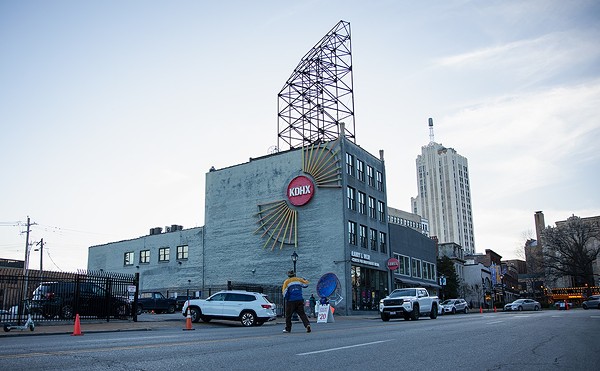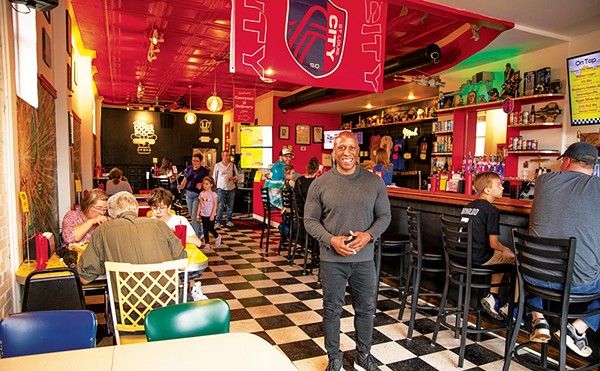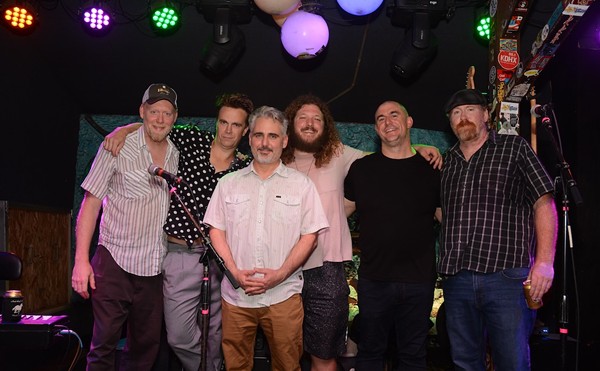and impossible to know. -- Nadine
San Diego, California. 1984. A thirteen-year-old Steve Rauner puts his electric piano through the paces of "Green Onions" and Ray Charles tunes. His friend since tricycle-riding days, Ben Davis, plays mini-Steve Cropper riffs on a guitar that looks like a hockey stick. They call themselves the Tin Lizards. The garage door is open, and they'll play past curfew.
Glenview, Illinois. 1987. A scrawny blonde-haired high-school kid is singing R.E.M.'s "The One I Love" at band practice. It's the only song he can remember. The bass player reaches over and turns the kid's amp down to zero. It's the second cover band to kick Adam Reichmann out.
Evanston, Illinois. 1987. Anne Tkach has never played bass before, but she's trying to catch the groove of "Stepping Stone" in an apartment filled with too many college girls, all trying to rock on instruments they barely know. She breaks up the band and is certain she'll never play music again.
Madison, Illinois. 1988. Jimmy Griffin swaggers through the lead of "Sweet Transvestite" from Rocky Horror Picture Show. His eye shadow drips, his tongue hangs out, his tie catches in the strings of his guitar. The joint is sold out; his cover band will make $1,200 that night.
Troy, Illinois. 1991. The Somethings are trying to get it together; they're barely old enough to drive, let alone get bar gigs, but they wear their influences like a mid-day hangover: Pearl Jam, Nirvana and Sinister Dane. The drummer, Brian Zielie, doesn't care: He plays as hard and loud as his skins will allow. Alt-country is starting to break just across the river; it's not his thing.
The members of Nadine have outlasted most of the scene from which they emerged in the mid-'90s for one reason: They've changed everything, save the one thing they can't change -- themselves. Their latest record, Strange Seasons, is a constellation of everything Nadine has ever done -- done now with greater urgency and greater understanding of where they come from and where they imagine they might go. Gone may be the studio experimentalism -- the subtle drum loops and atmospheric touches -- gone may be the signature sounds of Americana -- the mandolin, accordion and lap steel -- but what remains is the heart and soul of rock & roll, crafted with no pretensions, played with no inhibitions.
Because their first home was Glitterhouse, the German label known for supporting Americana bands too small for most American labels, and because their earliest ink dried in No Depression and European magazines (for whom any band with a harmonica qualifies as rootsy), the members of Nadine found themselves labeled alt-country, even though country music, no matter how you define it, has never been their goal. From the get-go their name didn't clarify matters.
"We were driving around downtown St. Louis," Rauner recalls, "and we realized we had to have a band name now, this week. We talked about what we didn't want it to be. Adam said, 'I don't want it to be some country-rock band name like fucking Nadine.' We looked at each other, and said, 'Fuuuuck.'"
But the return to American roots music in the '90s, a return led by bands like the Jayhawks, Blue Mountain and, needless to say, Uncle Tupelo, remains inseparable from the rock band Nadine has become. You can hear it in Rauner's deep Hammond B3 swirls, in Reichmann's tenderly frayed vocals, in the infinitely singable melodies and tube-driven tones. Even before Todd Schnitzer and Reichmann formed Sourpatch, the loose country-rock band that gave way to Nadine, the duo leaned toward music that was subtle and song-based.
"Todd and I were into this kind of adult contemporary music," Reichmann says of his early work with Schnitzer, whom he met in dorms of Washington University. "I was trying to write Robbie Robertson-type things; Todd was playing piano. Nobody made music like that. Everybody wanted to be so cool, sound like a Seattle band, be louder than everybody else. We were famously uncool."
But Nadine became cool, at least in Europe, where, after the release of Downtown, Saturday in 1999 and Lit Up From the Inside in 2000, the band was able to tour to borderline fanatic audiences, though no arrest warrants were posted in the States. After recording three gorgeous, remarkably different records but never quite finding a U.S. audience to support them, Schnitzer had had enough of touring.
After Schnitzer's departure in the spring of 2001, Rauner sold off much of the gear at the downtown space called Undertow. Nadine rebuilt the ProTools-based studio, but decided to make a live record with Centro-matic drummer and engineer Matt Pence in Denton, Texas. The sessions in January 2002 were their first foray into analog tape and their most intense collaboration with other musicians. Along with Pence, contributors included Will Johnson and Scott Danbom, also from Centro-matic, as well as St. Louis keyboardist John Parsons and ex-Brave Combo percussionist Joe Cripps.
"We wanted to do a live record, as a romantic concept," Rauner says. "I don't think that's so great anymore. After doing it for as long as we have, you can't fight who you are."
But just as soon as Nadine made their finest rock record, finding that ineffable, rhythmic groove, they lost it -- drummer Merv Shrock split on January 14, 2003. "When you have a personality conflict, and you can't let go, there's really nothing you can do," Tkach says. "There were two big Leos in the band, and that just didn't work."
For Nadine, making it work meant adding Jimmy Griffin, a slashing, flashing guitar player, part Keith Richards, part Ace Frehley, who, before joining the band in the fall of 2002, had worked the heavier side of the St. Louis scene. Before grunge killed off glam metal in the '90s, his band King of the Hill appeared on MTV and packed east side clubs like Stages.
But just as Nadine hoped to move from narrowly defined Americana, Griffin wanted a break from bands who were eternally cranked to ten. "As I've gotten older," he says, "I was playing these all-ages shows, where the girls in the front row were fifteen. I didn't want to be that guy any more. So what do you do after eyeliner and nail polish and looking like a freak? Nadine was the next logical step for me."
The band's newest member, drummer Brian Zielie, hails from that same hard-rock, cover-band world, but like Griffin, he wasn't long for it. "I got out of trying to making it with a band, the business and cliques," Zielie says. "I pretty much decided I'd never do the touring-band thing again."
Griffin and the handful of songs he heard before auditioning changed his mind. "I didn't know that much about Nadine," Zielie says. "People would say, 'You're going to play with that country band?' It's true that they had a fan base and a certain sound, and then Jimmy and I come in and we're wrecking it. Sometimes I wonder if people can handle what's happening."
All the changes, all the line-up shifts, all the seven years of work have brought Nadine to another turning point. This spring, the band signed to Trampoline Records, an LA outfit headed by Pete Yorn, Rami Jaffee of the Wallflowers and Mark Dauer of the Jukebox Junkies. There are no guarantees, but the deal with Trampoline means the band finally has a shot at an elusive stateside exposure.
Like the rest of Nadine, Tkach -- who has already been down the major-label road with her other band, Hazeldine -- sees the changes, keeps her hopes but pins nothing on them.
"I'm trying to develop my own relationship to making music on my own terms," Tkach says. "I don't think we harbor illusions. I do know that Trampoline loves our record, and it's not because I get a good bikini wax. Whether we play the House of Blues in LA or on Craig Kilborne's show, that's all incidental. That doesn't mean any more to me than anything else. I just want to live a true life."





